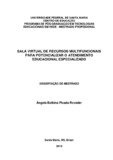| dc.creator | Roveder, Ângela Balbina Picada | |
| dc.date.accessioned | 2016-03-07 | |
| dc.date.available | 2016-03-07 | |
| dc.date.issued | 2015-08-11 | |
| dc.identifier.citation | ROVEDER, ângela Balbina Picada. VIRTUAL ROOM OF MULTIFUNCTIONAL RESOURCES TO ENHANCE THE SPECIALIZED CARE EDUCATION. 2015. 165 f. Dissertação (Mestrado em Educação) - Universidade Federal de Santa Maria, Santa Maria, 2015. | por |
| dc.identifier.uri | http://repositorio.ufsm.br/handle/1/10654 | |
| dc.description.abstract | This study linked to the line of research "Development of network educational
technology", from the Professional Master course on Network Educational
Technology, aims to contribute to the provision of Specialized Educational Service
(SES). To do so, it was sought to develop a Digital Educational Material (DEM) to
enhance SES; specifically the objectives were: 1) expand the SES, implementing a
DEM in order to be used presentially and at a distance; 2) adapt the pedagogical
model DEM, making it accessible to the target audience of the Special Education
Student (SPES) and 3) validate the possibilities of motivation, autonomy and learning
of DEM with SPES, under the assessment of SES teachers. On the basis of theories,
it can include four axes: first, contemplating the special education; the second, with
studies of digital educational materials, Learning objects; the third on Teaching
Design (TD) in the construction of DEM and the fourth axis referring to the
accessibility of digital educational materials. By applying a qualitative research, the
focus was on teachers who work in Multifunctional Resource Rooms, performing the
SES of state public schools in the city of Santa Maria, RS state. Data collected went
through content analysis (Bardin, 2011), using three categories: motivation for the
use of DEM, the autonomy in the use of DEM and potential for learning. The results
of the analyzed categories allow evidence that the motivation to use DEM is present
due to the context of illustrations, content and accessibility; as the autonomy, the
results indicate that the non-linear path and affordable navigation possibilities are
important characteristics for the development of a DEM, and finally, the potential for
learning is present from the developed educational activities in accordance with the
practices the SES and the possibilities of using DEM presentially and at distance.
Thus, the study achieved its goals, understanding that the virtual room of
multifunction resources gives SES greater potential. | eng |
| dc.format | application/pdf | por |
| dc.language | por | por |
| dc.publisher | Universidade Federal de Santa Maria | por |
| dc.rights | Acesso Aberto | por |
| dc.subject | Sala de recursos multifuncionais (SRM) | por |
| dc.subject | Atendimento educacional
especializado (AEE) | por |
| dc.subject | Material educacional digital (MED) | por |
| dc.subject | Educação especial e inclusiva | por |
| dc.subject | Multifunctional resource room (MRR) | eng |
| dc.subject | Specialized educational service
(SES) | eng |
| dc.subject | Digital educational material (DEM) | eng |
| dc.subject | Special and inclusive education | eng |
| dc.title | Sala virtual de recursos multifuncionais para potencializar o atendimento educacional especializado | por |
| dc.title.alternative | Virtual room of multifunctional resources to enhance the specialized care education | eng |
| dc.type | Dissertação | por |
| dc.description.resumo | O presente estudo vinculado à linha de pesquisa Desenvolvimento de
tecnologias educacionais em rede , do Mestrado Profissional em Tecnologias
Educacionais em Rede, pretendeu contribuir com a oferta do Atendimento
Educacional Especializado (AEE). Para tanto, buscou desenvolver um Material
Educacional Digital (MED) para potencializar o AEE; especificamente os objetivos
foram: 1) ampliar o AEE, implementando um MED de forma a ser utilizado presencial
e a distância; 2) adaptar o Modelo Pedagógico MED, tornando-o acessível ao
Estudante Público-alvo da Educação Especial (EPAEE) e 3) validar as
possibilidades de motivação, autonomia e aprendizagem do MED com os EPAEE,
sob a avaliação dos professores do AEE. Nas teorias de base, referenciam-se
quatro eixos: o primeiro, contemplando a Educação Especial; o segundo,
apresentando estudos sobre Materiais Educacionais Digitais, objetos de
Aprendizagem; o terceiro, sobre Design Pedagógico (DP) na construção dos MED e
o quarto eixo referindo-se à acessibilidade em Materiais Educacionais Digitais. Com
uma pesquisa qualitativa, aplicada, o foco recaiu sobre professores que atuam nas
Salas de Recursos Multifuncionais, realizando o AEE de Escolas Públicas Estaduais,
na cidade de Santa Maria, RS. Os dados coletados passaram pela análise de
conteúdo (Bardin, 2011), por meio de três categorias: motivação para o uso do MED,
autonomia no uso do MED e potencial para a aprendizagem. Os resultados das
categorias analisadas permitem evidenciar que a motivação para uso do MED está
presente devido à contextualização das ilustrações, conteúdos e acessibilidade;
quanto à autonomia, os resultados apontam que o percurso não linear e as
possibilidades de navegação acessíveis são características importantes para o
desenvolvimento de um MED e, por fim, o potencial para aprendizagem se faz
presente a partir das atividades pedagógicas elaboradas de acordo com as práticas
do AEE e das possibilidades de uso do MED presencial e a distância. Assim, o
estudo realizado contemplou os objetivos, entendendo que a Sala virtual de
Recursos Multifuncionais potencializa o AEE. | por |
| dc.contributor.advisor1 | Siluk, Ana Cláudia Pavão | |
| dc.contributor.advisor1Lattes | http://lattes.cnpq.br/7103505448590793 | por |
| dc.contributor.referee1 | Schlünzen, Elisa Tomoe Moriya | |
| dc.contributor.referee1Lattes | http://lattes.cnpq.br/7346754405819238 | por |
| dc.contributor.referee2 | Pavão, Sílvia Maria de Oliveira | |
| dc.contributor.referee2Lattes | http://lattes.cnpq.br/6934897603622261 | por |
| dc.creator.Lattes | http://lattes.cnpq.br/9097507951023038 | por |
| dc.publisher.country | BR | por |
| dc.publisher.department | Educação | por |
| dc.publisher.initials | UFSM | por |
| dc.publisher.program | Programa de Pós-Graduação em Tecnologias Educacionais em Rede | por |
| dc.subject.cnpq | CNPQ::CIENCIAS HUMANAS::EDUCACAO | por |


